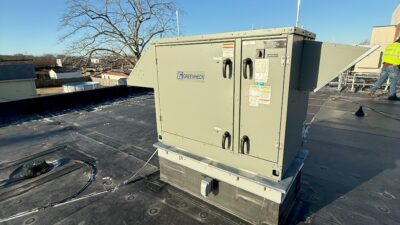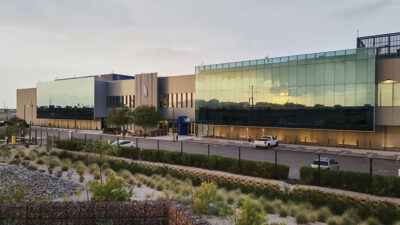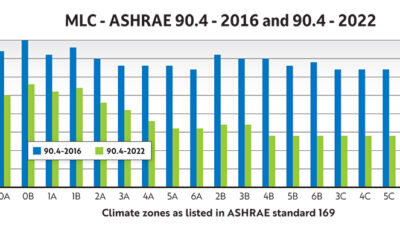Rising fuel prices have dealt a setback to the distributed generation movement and its advocacy of on-site power. But there are still a number geographic regions and types of facilities where the technology makes sense. “While the basic idea is still good, the cost of natural gas has increased to the point that, on a Btu basis, natural gas and electricity are very close in cost,” sa...
Rising fuel prices have dealt a setback to the distributed generation movement and its advocacy of on-site power. But there are still a number geographic regions and types of facilities where the technology makes sense.
“While the basic idea is still good, the cost of natural gas has increased to the point that, on a Btu basis, natural gas and electricity are very close in cost,” said Ken Lovorn, PE, president and chief engineer, Lovorn Engineering, Pittsburgh. “This makes the prototypical co-generation plant uneconomical for all but very special situations.”
According to other engineers, however, those special situations aren’t necessarily so uncommon. Driven by power reliability issues, the need to save on energy costs, and public incentives, distributed generation continues to be a noteworthy trend in places where electricity tends to be more expensive, such as the U.S. East and West Coasts, Europe and Latin America.
“In New York, cogen makes a great deal of sense,” said Sheldon M. Steiner, PE, senior vice president, Flack + Kurtz, New York. “We’re seeing cogen projects of every size. I think there’s greater interest than I’ve seen in a while.”
DG success stories
In cases where the variables fall in place, on-site cogeneration has been effective. For example, in Latin America, a couple of large Cummins projects have helped end users reap significant savings.
Pastas Doria, a large pasta products manufacturer near Bogota, Columbia, was losing valuable production time as a result of frequent utility voltage instability and power failures. Responsible for 40% of all pasta products consumed in the country, the company installed a combined-heat-and-power (CHP) system with a lean-burn 1,750-kW natural gas generator set.
The generator set operates full-time, in parallel with the local utility, in order to stabilize the voltage of incoming power. In addition, waste heat is captured to provide 3.4 million Btu/hr of heat energy to the plant’s boilers, pasta drying operations, and space heating, leading to additional savings in fuel oil costs.
“The company estimates that it has reduced its electricity purchases by 60% and its fossil fuel purchases by 70%, resulting in savings of approximately $50,000 per month on its energy bills,” said Keith Packman, gas applications manager, Cummins Power Generation, Ramsgate, U.K.
In neighboring Brazil, the city of Sao Paulo’s 1.75 million sq.-ft. mixed-use World Trade Center complex is now using three 1,750-kW gas-powered generator sets with a total generating capacity of 5.25 MW. Primarily used to reduce the cost of energy during peak demand periods, the sets run parallel to the utility in order to independently power the complex in the event of a utility power outage. In addition, a “black start” diesel generator provides system starting capability during a total outage.
“By being able to produce their own power, [the World Trade Center] is able to save as much as 30% on energy costs during peak hours,” said Packman.
And in southern California, another strong case study of distributed generation is now up and running at Western Milling, a large animal feed supplier based in Goshen. With a very large electrical and thermal load required for running conveyors, mixers, grinders, blenders, and pellet mills to produce liquid, bagged, and bulk animal feed products, it was logical for the manufacturer to generate some of its own power, especially in such a high electrical rate area.
Consequently, Western Milling went with a natural-gas-engine generator capable of producing 1,250 kW of electricity, 2,200 lbs. of steam at 115 psi, and 30 gallons per minute of hot water at 190
Although the mill has been more than pleased with the installation, before getting the plant up and running, they had to deal with the fact that on-site power generating systems in the state of California are straddled with the most restrictive environmental standards anywhere in the world.
“As a result,” said Packman, “the system includes a selective catalytic reduction system on the generator set’s exhaust that uses a urea injection to reduce the NOx in the engine’s exhaust. After treatment, NOx in the exhaust stream is reduced to just 5 ppm, which is about half of the amount allowed in the standard.”
On the boards, one major project posed to use its own large on-site generation plant is the MGM City Center in Las Vegas. Said to be the largest non-government project currently being built in the United States, the 76-acre, 10 million sq.-ft., $7.4 billion mixed-use complex will have a 50-MW electrical load, according to Steiner. With two 4-MW combustion turbines producing electricity and steam, the plan is for 8 MW of that total load to be taken care of by the city center’s own plant.
Methane mania
Another variety of on-site generation that is slowly gaining acceptance is landfill methane. Essentially, by drawing out the methane that comes from decaying garbage, a high quality, inexpensive fuel is captured.
“In the case of landfill, it often makes economic sense to use the methane and get a payback from it,” said Michael A. Devine, gas product marketing manager, electric power group, Caterpillar, Mossville, Ill. “They have to collect the gas and destroy the methane anyway, so getting revenue for the sale of electric power makes economic sense. Payback from the equipment investment often takes only between three and five years.”
For instance, in Dunbar, Scotland, a waste management company uses two 1.74-MW low-Btu gas generator sets to produce 3.5 MW of energy from methane drawn from a site. The company was able to set up an agreement with a nearby cement plant to purchase the electricity at lower than utility cost. In all, the methane-fueled electricity is currently taking care of 15% of the plant’s total electrical needs.
Another boon for the waste management company, in this case, was the project’s ability to qualify for what’s called renewable obligation certificates in Scotland. Basically, for every megawatt-hour of electricity generated, a return on capital is produced and may be traded into a market mechanism worth between $80 and $90 USD.
While the Scottish company is greatly benefiting from its government’s support of renewable energy, things unfortunately doesn’t always work out so smoothly.
“Because of increasing interest in sequestering methane and CO2, landfill, digester and ag-biogas applications have taken off worldwide, but the growth of these markets is not happening universally,” said Devine. “The more industrialized a society, the greater the likelihood for technologically advanced waste management capable of successfully supporting a DG system.”
For example, on a recent project Lovorn was involved with, the end user had installed equipment to use land-fill methane for powering their entire facility. “The original design intent was to sell the energy not needed to operate the site to the local electrical utility, but they decided that the federal law—the Energy Policy Act of 2005—did not apply to them, so they [the utility] declined purchasing the excess electrical power after all the metering and relaying was already designed and installed.”
Unfortunately, said Lovorn, it is cases such as this that stand in the way of a greater use of methane.
“As long as the local utilities impede purchasing these recovered assets, the installations of the recovery systems and generation equipment must have significant incentives to make the projects economically viable,” he said.
Lovorn also points out that even when utilities are willing to purchase the electricity, they are notorious for making the purchase based upon avoided costs, which is a mere 10% to 20% of what they will eventually re-sell the electricity for.
“If the buy price from the electrical utility was 90% of the sell price, I believe that there would be an explosion of distributed power generators throughout any location where there was an available source of waste methane, i.e., agricultural waste streams, feed lots, landfills, coal mines, sewage, flares at refineries, and oil pumping field,” said Lovorn.
Incentive enough?
In general, Lovorn also sees a lack of government incentives and utility cooperation hindering a greater adoption of cogeneration as well. “In the past, there were a number of incentive programs available to encourage the proliferation of small, distributed generation plants. Many of these programs have expired and have not been renewed, plus the electrical utilities resist their connection into the electrical distribution grid, so there seem to be fewer opportunities to develop these alternate power sources.”
At the same time, Rajan Battish, PE, principal, RTKL Assocs., Baltimore, points out that a strong movement toward sustainable design—i.e., the new requirement that federal facilities become LEED silver-certified and the new EPACT 2005 requiring new buildings to achieve energy consumption less than 30% of ASHRAE standards—may help distributed generation along.
Anil Ahuja, PE, RCDD, LEED AP, president, CCJM Engineers, Chicago, agrees citing a greater focus on global energy issues as another potential driver. “I think there will be more incentives to promote this, and this will give distributed generation and alternative energy projects a jump start.”
For example, said Ahuja, currently in Chicago permits for LEED projects are expedited and sometimes fees are even waived.
And in New York, NYSERDA gives up to $2 million for cogen projects, according to Steiner. “Such incentives are important because they make projects that are marginally appropriate, more appropriate. We recently did a project with this NYSERDA grant, and without it, the project might not have gone through.”
According to Devine, there is also a federal program offering $0.09—0.10 per kilowatt hour as a tax incentive for power producers utilizing landfill gas.
But besides coming up with the construction dollars, end users also have to deal with issues of attaining permits, noise from the plant, controlling emissions and arranging for the regular delivery of fuel at a reasonable cost.
“Especially in non-attainment areas, predominantly where the power is short due to high demands, there are obstacles to permits for on-site generation,” said Battish. “Unfortunately, this is especially the location where cogeneration will benefit the most.”
In any case, regarding other issues, Ahuja recommends noise absorption sound attenuators, installing catalytic converters on the exhaust, and wisely negotiating with fuel suppliers.
Yet another point that must be dealt with is a lack of uniform utility interconnect specifications, according to Mike Dauffenbach, technical sales manager, Katolight, Mankato, Minn. “Hopefully, IEEE 1547 will address this issue in the near future.”
And concerning methane, Devine explains that methane concentration varies over time in different sites. “Even weather conditions, like rainfall or hours and intensity of sunshine can affect the methane and CO2 ratio at a facility. In addition, changing levels of contaminants like siloxanes, hydrogen sulfides and halides also affect engine maintenance intervals.”
To address these concerns, some manufacturers are working to fine tune their engines to be more fuel flexible and tolerant to common contaminants. In addition, educating end users to understand, monitor and maintain their systems will achieve greater efficiencies.
Future needs
With an eye toward the future, another trend Dauffenbach notes is the fact that the nation’s power requirements are continually increasing, yet new power plants are not being built. At the same time, the price of control panels for the generator set industry has come down making the technology for economically viable.
“We can foresee a time in the near future when engine generator sets will be a necessary and reliable crutch until more power facilities can be built,” he predicts.
A New Twist on Methane
A fairly new twist on the use of methane involves taking waste methane from inactive coal mines. By extracting nitrogen, carbon dioxide and water vapor, the final product is equal in quality to the natural gas methane recovered from oil or gas wells.
“This same gas fires the boilers that are a part of the process for recovering the methane for eventual sale,” explained Ken Lovorn, P.E., president and chief engineer, Lovorn Engineering, Pittsburgh.
“In a similar process, methane from unmined coal beds is recovered, processed, and pumped into the natural gas pipelines. This not only uses a product that is normally wasted, but in the process of removing the methane from the coal beds, the occurrence of methane in the coal mines is reduced when the mine is extended to these areas where the methane has been extracted, making the mining process safer,” said Lovorn.
Lovorn also notes that this methane recovery process is already commercial viable and is in use in a number of areas.
On-site Cogeneration: Weighing the Costs
Determining whether an on-site cogen installation is logical for a facility depends on a number of criteria, according to Keith Packman, gas applications manager, Cummins Power Generation, Ramsgate, U.K. A checklist of such variables includes the following items:
• Cost of electricity.
• Cost of natural gas.
• Determination that there is a use for both electricity and waste heat.
• Local ordinances regarding emissions and noise.
• The availability of rate rebates, tax credits, and subsidies.
• Cooperation from the local utility regarding interconnection.
• Sufficient space to store on-site equipment.



